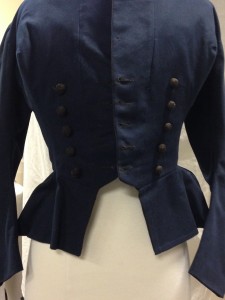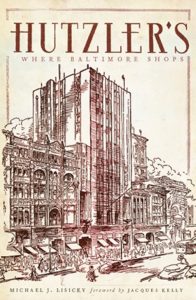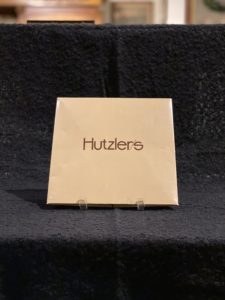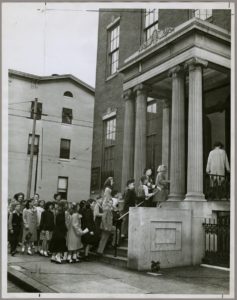Riding Habits and Women's Rights
Editor’s Note: Support the Maryland Historical Society by participating in our Adopt A Box! program. For as little as $100 you can help preserve these treasures for future generations.
By: Emily Bach
Horseback riding has been part of history for thousands of years. As a sport, it began in ancient Greece over 2,000 years ago when Greek soldiers introduced “dressage”, a series of movements performed by the horse, to prepare the horse for war. During the Middle Ages in Europe, equestrian sport and riding became an indicator of noble blood. Similar to the Greeks, Medieval knights trained horses in tournaments and jousts, as well as combat events where the horse and rider practiced cooperating in a war-like scenario. During the Victorian Era, horseback riding became popular as entertainment as men and women both participated in fox hunts and leisurely excursions. Throughout history, equestrianism has been known as a physically straining and elegant activity, requiring it to have specially designed clothes to match both practicality and elegance. Female riding gear has transitioned from intricate, frilly gowns to today’s uniforms that are almost identical to men’s wear. Rather than changing to reflect the common fashion trends of the period, women’s riding gear embraced masculine styles as women demanded more liberty and freedom from restrictive societal expectations, marking equestrianism and riding wear as a symbol for women’s reform movements.
During the 18th century, when women rode horses they wore extravagant jewels, luxurious trims, expensive laces, and other impressive accessories to focus attention onto them. Riding a horse placed the rider on a pedestal since he or she was significantly high above the ground, symbolizing that the rider was higher above in status. Intricate riding wear signified a woman’s royal status, yet as the 19th century moved forward, women and men both criticized overly decorated riding costumes. Practicality became more important than fashion.
Equestrian sport also posed a danger to women, which caused further change in women’s riding dress. The riding habit focused on ease of mobility. Skirts could not snag on the horse’s hooves or any terrain because of the possibility of being trampled, causing the riding habit’s skirt to shrink, even during the height of crinoline skirts. The habit’s jacket featured looser sleeves and collars to ensure a woman’s ability to hold the reins and observe her surroundings. Two riding habits we rehoused showcase these qualities. The collars on both jackets are small and do not rise high above the neck, allowing the woman to turn her head with ease. The black riding habit’s jacket features loose sleeves, especially at the shoulders where there is a little kick-up. This would allow the woman to rotate and raise her arms as situations required.
Many men feared a woman’s sense of freedom while riding. Many even called her an “Amazone”, the French word for Amazon, the Greek warriors renowned for their vicious battle skills and riding abilities. They feared these women because they embraced masculine qualities. Rather than going to dressmakers for riding habits, women hired tailors. Tailors used fabrics typically used on men’s clothing for these habits, allowing women to wear black, gray, and navy, palettes usually attributed to men. Tailors also constructed the habit’s jacket to resemble a man’s jacket, a definite change in attire compared to the 18th century focus on frills. Both of our collection’s riding habits also include these masculine, utilitarian jackets. The collection's navy wool jacket is double breasted, showcasing a militaristic quality similar to men's uniforms.
The combination of looser fitting clothing and masculine features became a manner of rebellion for women. Rather than accepting society’s expectations and social norms, women riders distinguished themselves from the dominant culture. The Dress Reform and Rational Dress Movements supported this claim of moving against societal dictation of how women should dress. Women criticized any decorations on riding habits, claiming unnecessary accessories were irrational and depicted the rider as vain and selfish. One picture shows a woman on horseback wearing a straight-lined habit while her assistants wear full skirts with fancy trims, emphasizing the drastic difference.
 Image of a woman wearing a riding habit surrounded by women wearing the fashionable dress during the era. Emphasizes how riding habits freed women from dress expectations.
Image of a woman wearing a riding habit surrounded by women wearing the fashionable dress during the era. Emphasizes how riding habits freed women from dress expectations.
Although the habit featured feminist qualities, it still followed regulations. Skirts were specifically made to never show the rider’s legs, as that would be immodest. In order to prevent a show of legs while dismounting, women often put lead weights on the hems of their skirt, built in pockets that attached to the saddle, or sewed in elastic bands on the inside of the skirt to go around her legs. One skirt from the MdHS collection features these elastic bands, showing how although the jacket has a militaristic undertone, a woman still had to protect her reputation. Skirts also were sewn to accommodate riding side saddle, a position men for centuries claimed benefited a woman’s posture and showcased grace. The skirt’s special construction can be seen in our black riding habit. One side of the skirt is longer than the other side, a feature meant to prevent the rider's skirt from catching on anything.
As the reform movements progressed, women directly attacked these restrictive qualities of the riding habits. Reformists stated riding astride was healthier than side saddle. They claimed sidesaddle hurt a woman’s spine because rather than being perfectly centered on the saddle, the woman’s slanted body curved the spine. Women began to choose riding astride, influencing trousers to be worn frequently under the skirt, which shortened over time. These trousers, called jodhpurs, resembled the trousers of men. Women began wearing jodhpurs in the 1920s. When comparing the collection’s two pair of Jodhpurs both worn by Jervis Spencer Jr. (winner of the Maryland Hunt Cup between 1899 and 1922) to a photograph of a woman wearing riding trousers, it can be seen how this type of riding wear allowed women to gain a certain amount of equality to men through fashion and sport. Women gained equality in the sport of horseback riding in 1951 when the Olympics allowed women to compete in the horseback riding events with men. Since 1952 women have competed with men in mixed events. As women sought equality, fashion gravitated towards masculine trends and symbolized a woman's effort to gain liberties and freedom.
- SVF Maryland Historical Society Students Entering Pratt House Jack Engeman Studio, May 1950. 8 x 10 inch photo print Subject Vertical File Special Collections Department
Learn more about how you can save these treasures by participating in our Adopt A Box! program. We thank you for your support!
References:
file:///C:/Users/Emily%20Bach/Downloads/Victorian%20Riding%20habits%20%20(2).pdf





